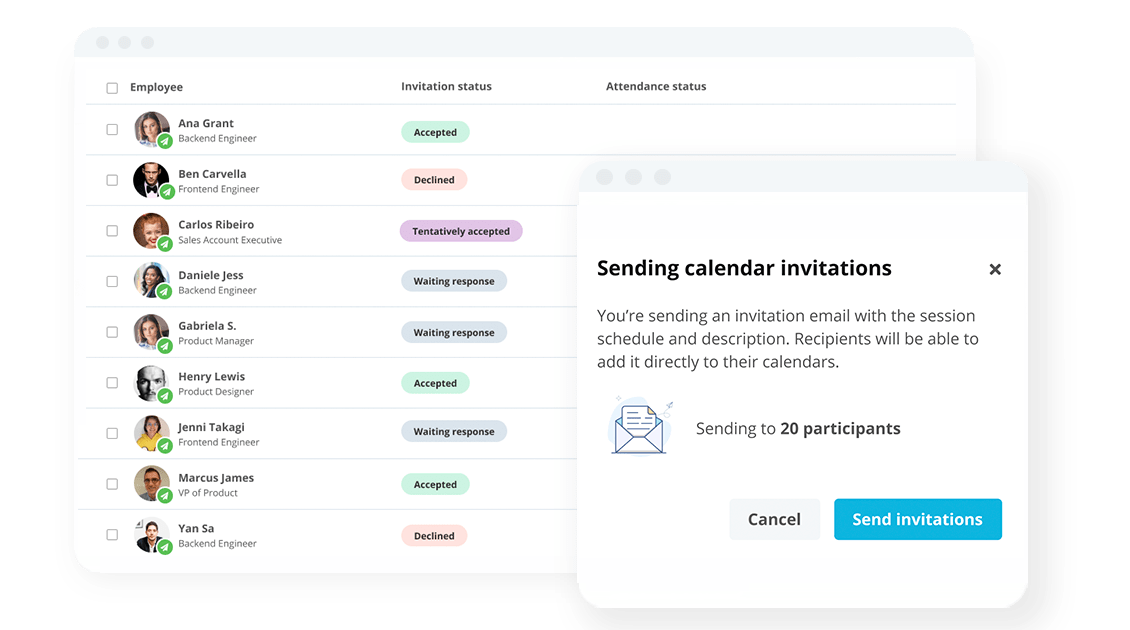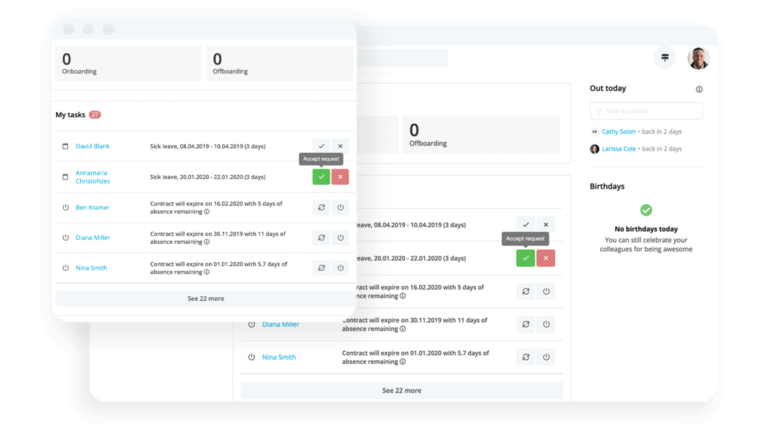
Give the Right Training at the Right Time
Simplify your staff development with centralised training management.
Secondment: A Comprehensive Guide

Secondments are a method of sending employees out to learn new skills and bring them back to your team. In this guide, we talk about what secondments are, how they typically work and the benefits they can bring to your entire workforce (and not just individual employees).
Key Facts
A secondment sends employees to different departments or even to other companies so they can learn new skills or assist on complex projects.
Many employers have workers sign contracts before going to a host organisation to outline expectations and emphasise confidentiality.
Secondees often have to handle certain administrative responsibilities of their normal role along with the tasks of the new one.
What Is a Secondment?
A secondment is when a company assigns an employee or group of employees to a new, temporary position while retaining their normal benefits and salary. The new position can be in another department in your company or with a host organisation.
The employees, called secondees in this arrangement, are assigned a project and return to their original position once completed.
When Do Secondments Typically Happen?
Secondments are used for various reasons. Their ultimate goal is to benefit the company, whether through learning valuable new skills or enriching an employee with more in-depth knowledge about how your company works.
While it might not be the most suitable option for newer organisations, the bigger a company grows, the more viable secondments usually become. Secondments are often utilised for:
Career development
Skill development
Cover for long-term absences such as parental leave
Avoiding redundancies
Letting employees stay to retain benefits while working for another organisation
Using an employee's expertise to benefit another department or organisation
What Are Examples of Employee Secondments?
An employee from the sales department is sent to the marketing department to help guide future marketing directives to better align with sales goals. Additionally, the secondee gains greater insight into the marketing process and could learn more creative ways to talk about their product.
A senior HR representative from Company A is sent to Company B for one year to help adjust their people management practices. The consultant brings prior expertise in settling disputes, career development and creating a positive work environment. In return, they could learn how to construct effective HRM policies from the ground up and bring those skills back to Company A.
A company specialising in professional development and high-level training sends one of their most experienced trainers to one of their client companies. While there, they work with the HR department to reexamine the company training programmes and development policies, making changes to better align with company goals. The reevaluation helps push employee skills and knowledge in the best direction possible.
How Do Secondments Work?
Most companies have official processes letting employees formally request a secondment, but others will offer the opportunity directly to an employee. Either way, building a sound secondment process ensures that all parties get what they want and need out of the relationship.
1. Determining Length
Secondments typically last for several months or even a year. Make sure the amount of time on a secondment is predetermined before an employee commits.
2. Clarifying Employment Relationships
Typically, a company will continue to employ workers sent to other companies for their secondment, but that’s not always the case. Some organisations let the host business temporarily place the transferred workers on their payroll and potentially benefit from certain company perks. The employment contract must outline this arrangement to avoid misunderstandings between your company, the third party and the employee.
3. Considering Expenses
Because the secondee often takes on more responsibility than their original position requires, additional compensation may be in order. There may also be costs of relocating employees and providing additional training that lets them seamlessly adapt to the new environment. Ensure to clearly communicate with the employee and the other company (if applicable) to ensure all parties are clear on their responsibilities and the employee knows what to expect.
4. Clearly Stating Responsibilities
Make sure to clarify the secondee’s responsibilities while they’re within a new department or organisation. Figure out how much of their typical tasks you expect them to fulfil during their secondment. A work contract should also list the new responsibilities to help them plan their temporary work schedule.
5. Outlining How to Handle Conflicts of Interest
Usually, the original company will specify that the secondee must report any conflicts of interest they experience in their temporary position. Create a process for handling these situations that ensures all parties remain satisfied with the arrangement.
7. Taking Confidentiality into Account
If an employee goes to another company, confidentiality can be a concern for both parties. Work with the other organisation to outline the secondee's responsibility to protect sensitive information. They shouldn’t share anything they know about the original company with the third-party organisation. No critical information learned during their secondment should be shared with the original company once it’s over. Consider preparing a confidentiality agreement that your employee must sign before stating their secondment.
People Workflow Automation: Putting Productivity In Focus
People Workflow Automation helps your organization remove delays in order to realize opportunities. Click the button below to learn more about how it works for your team.
Take the JourneyAdvantages and Disadvantages of Secondments
Like many initiatives meant to help with employee professional development or improve productivity within the workplace, secondment comes with several benefits and drawbacks, including:
Advantages | Disadvantages |
|---|---|
Higher employee retention. Secondment can help fully invest employees in the daily operations of your business. A solid connection to several departments' workings creates a sense of loyalty to the organisation, encouraging workers to stay on long-term. | It can be difficult to settle into a new role. Some employees may need more time than others to adjust to their new responsibilities in a role where time may be of the essence. Workers may feel unsettled with the situation and unable to perform at their best. |
Creates stronger workplace cohesion. Secondments help employees learn about their peers from every level of the company. The greater understanding between different departments helps foster a more collaborative atmosphere while helping make those collaborations more effective. | It takes time to readjust to their regular job. It can be challenging for employees to adjust to their permanent positions when the secondment is over. The former secondee’s inability to adjust to the new circumstances could affect their long-term performance. |
Departments can get additional help. A secondee can help during busier times of the year. Recruiting someone with expert skills can help chew through a backlog of work and resolve issues that others might not have experience with. | It could mean twice the work for some. Secondees often have to complete the administrative tasks for their permanent position alongside their new responsibilities in secondment. Carefully consider the scope of both positions to minimise the risks here. |
They can lessen worker burnout. Temporarily shifting employees to new responsibilities within your company or a third-party organisation helps keep their regular jobs feeling fresh. A change of pace helps keep your staff energised so they can continue to perform. | It can disrupt work-life balance. Adding the tasks of another position to an employee's responsibilities can understandably harm their personal time. With fewer opportunities to unwind, it’s possible that a secondee’s stress can build uninterrupted until it starts to affect their performance in both roles. |
Frequently Asked Questions About Secondments
What Does Secondment Mean?
Secondment means assigning employees to a new, temporary position within the company or with a host organisation.
Who Pays a Secondment’s Salary?
The employee's original company pays their salary unless the host organisation agrees to pay them instead as part of the secondment contract.
What Are the Benefits of a Secondment?
Some of the benefits of implementing a secondment programme include:
Higher employee retention
Stronger workplace cohesion
Expert assistance when your company needs it
Lower worker burnout
Better-utilised staff
What Type of Employment Is a Secondment?
Secondment is a type of temporary employment where employees work within the role for a set period.
Realise the Full Potential of Your Entire Workforce
Secondments can provide an ideal environment for your workers to learn new skills and responsibilities while temporarily putting them in positions where they can be the most effective.
To identify the best people, trust Personio’s Performance feature to help run reviews, host better development discussions and even tie goals to bonuses. Speak with an expert today.
Disclaimer
We would like to inform you that the contents of our website (including any legal contributions) are for non-binding informational purposes only and does not in any way constitute legal advice. The content of this information cannot and is not intended to replace individual and binding legal advice from e.g. a lawyer that addresses your specific situation. In this respect, all information provided is without guarantee of correctness, completeness and up-to-dateness.
